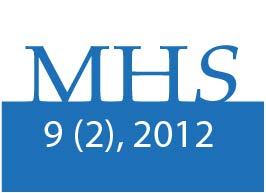Physical activity of Mexican youth: a comparative analysis between public and private universities
DOI:
https://doi.org/10.15359/mhs.9-2.1Keywords:
Physical activity, young, technology.Abstract
Physical activity appears in history from the moment when the human being comes in the face of the earth as a character inneed of movement, which has appeared since the beginning of mankind in various aspects such as mechanical motion, andsocial work. This has evolved directly in proportion to human development, reaching today to stand as a vital part of the training of individuals and as an indispensable means to achieve health, but there is also a bias in the practice of this activity and sport, which has created a cult of the body based on a postmodernism influenced by the mass media and standards of an alleged physical beauty sometimes unattainable human reality which has led to the presence of physical, biological, but equally psychological way, affecting self-esteem and self-image of young people and adolescents, which is in search of his identity. These kids today are influenced by a lifestyle dominated by modernity and technological advances, resulting in a sedentary lifestyle which adversely in every way and all areas, which coupled with institutional programs educational system and countless sports established deficiencies, leads to further complicate the situation, where you add harmful factors ranging from ignorance, inability and personal interests, which do not help us to build alternatives to start working. It is essential to establish an early and effective aimed at systematizing adequate physical activity based on scientific arguments and methods in line, we can provide various benefits given practice and help us stop the process of physical deterioration which the pace of modern life does not shed.
References
Blanco, S. (2006). Las tecnologías de la información y comunicación: factores determinantes de los cambios culturales entre jóvenes usuarios. Razón y Palabra. Tecnológico de Monterrey Campus Irapuato.
Carratala, V. y Carratala, E. (1999). El judo en edades tempranas. Una propuesta de competición. Ponencia en el primer congreso de la actividad física y el deporte en la universidad. Universidad de Valencia. Facultad de Ciencias de la Actividad física y el deporte.
Devís, J. y Peiro, C. (1997). Nuevas perspectivas curriculares en Educación Física: la salud y los juegos modificados. Zaragoza, España.
Devís, J., & Peiro, C. (1992). Exercise and health in a Spanish physical education curriculum: A modified programme of “The exercise challenge”. En T. Williams, L. Almond y A. Sparkes (eds.) Sport and physical activity: Moving towards excellence, Londres.
García, H. (2011). Nadie sabe a donde llegará la expansión de las RSD: expertos. En periódico La Jornada, México; 14-junio-2011. Recuperado desde:
www.jornada.unam.mx/2011/06/14/sociedad/040nlsoc.
Gutiérrez, S. (1995). Valores sociales y deporte. Editorial Gymnos, Madrid, España.
Grandes, G.; Sánchez, A.; Torcal, J. (2003). Protocolo para la evaluación multicéntrica del programa experimental de promoción de la actividad física. Atención Primaria, 475-480. https://doi.org/10.1016/S0212-6567(03)79318-4
Moya, S., García, A., Lucena, N., Casañas, R., Brito, P., Rodríguez, A., Flores, Z. y Cordero, R. (2006). Hipocinetismo: ¿un problema de salud en los jóvenes ucevistas? RFM, 1(29), junio, Caracas.
Paffenbarger, R.S., Hyde, R.T., Wing, A.L., Lee, I.M., Jung, D.L., & Kampert, J.B. (1993). The association of changes in physical-activity level and other lifestyle characteristics with mortality among men. New England Journal of Medicine, 328, 538-545. https://doi.org/10.1056/NEJM199302253280804
Pate, R. (1995). Physical activity and health: dose-response issues. Research Quarterly for Exercise and Sport, 66(4): 313-317. https://doi.org/10.1080/02701367.1995.10607917
Quevedo, L. (2003). La escuela frente a los jóvenes, los medios de comunicación y los consumos culturales en el siglo XXI. Educación media para todos. UNESCO-ALTAMIRA-FUND. OSDE. Buenos Aires.
Ramírez, W., Vinaccia, S. y Suárez, G. (2004). El impacto de la actividad física y el deporte sobre la salud, la cognición, la socialización, y el rendimiento académico: Una revisión teórica. Revista de Estudios Sociales, 18, 67-75.
Rodríguez, F. (1995). Prescripción de ejercicio y actividad física en personas sanas (I). Principios generales. Atención Primaria, 15, 190-194.
Santos, S. (2005). La educación física escolar ante el problema de la obesidad y el sobrepeso. Revista Internacional de medicina y Ciencias de la Actividad Física y el Deporte, 5.
Simons-Morton, B. G., & Parcel, G. S. (1988). Health-related physical fitness in childhood: status and recommendations. Annual Review of Public Health, 9, 403-425. https://doi.org/10.1146/annurev.pu.09.050188.002155
Varo Cenarruzabeitia, J. J., Martínez Hernández, J. A. y Martínez González, M. A. (2003). Beneficios de la actividad física y riesgos del sedentarismo. Medicina Clínica. Madrid España.
WHO. (1998). Obesity: Preventing and Managing. The Global Epidemic. Report of a WHO Consultation on Obesity. Geneva.
Downloads
Published
How to Cite
Issue
Section
License
General conditions
MHSalud: Journal in Human Movement Sciences and Health by the Universidad Nacional is cover under a Creative Commons Atribución-NoComercial-SinDerivadas 3.0 Costa Rica license.
The journal is hosted in open access repositories such as the Institutional Repository of the Universidad Nacional, the Kimuk Repository of Costa Rica and La Referencia.
The editorial source of the journal must be recognized. Use the doi identifier for this purpose.
Self-archiving policy: The journal allows the self-archiving of the articles in their peer-reviewed version, edited and approved by the Editorial Board of the Journal to be available in Open Access through the Internet. More information in the following link: https://v2.sherpa.ac.uk/id/publication/25815



















